Estimated reading time: 9 minutes
We want to talk about curly leaves on fruit trees. Even though the issue often appears in spring (or even summer), prevention actually starts in winter.
Leaf curl is a topic that’s dear to our hearts because we’ve had SO much experience with it. And we know it causes confusion for lots of home growers, because it’s one of the topics we’re often asked about.
What causes curly leaves on fruit trees?
There are lots of potential causes for curly leaves, and they’re all different.
The four most common types are caused by (a) fungal disease, (b) insects, (c) nutritional problems, and (d) the tree getting the wrong amount of water.
The most common cause of curly leaves in peach and nectarine trees is a fungal disease called—wait for it—Leaf Curl.
We’ve grown more than 20 different varieties of peaches and nectarines over the years on our farm. And we’ve grown them in a wide range of conditions from drought to flood and everything in between.
Over the years, it’s fair to say we’ve had a lot of experience with Leaf curl.
It’s a very common disease, and in fact, ONLY infects peaches and nectarines. Most gardeners are very surprised to learn that curly leaves in plums or citrus, for example, are caused by completely different things.
Identifying leaf curl
Leaf curl disease shows up in spring, does the damage, and then disappears (until next spring).
If your trees were infected last spring, they should have completely recovered by mid to late summer. They usually grow lots of healthy new leaves (like the photo below).
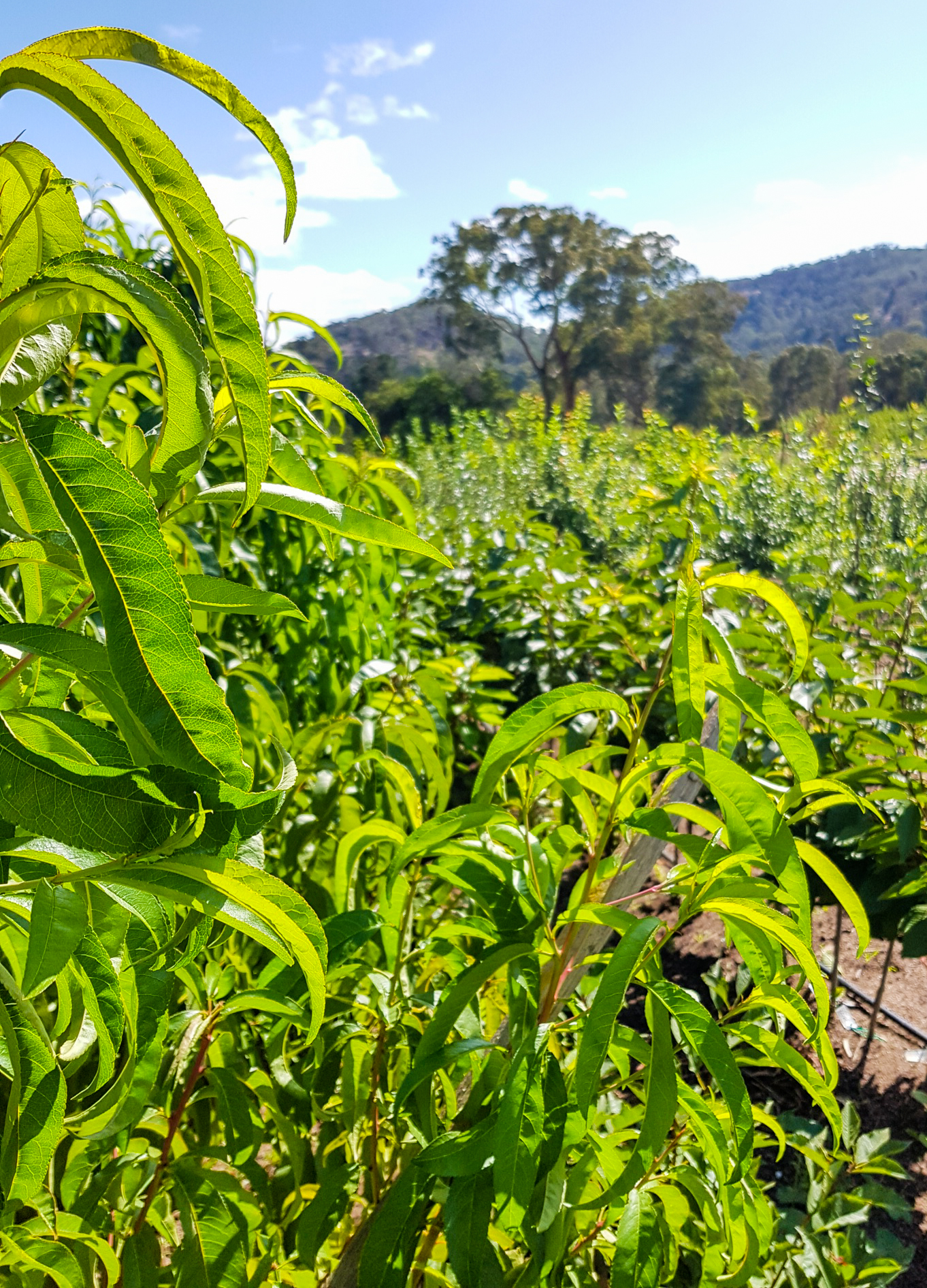
However, you may still be able to find signs of it, if you know what to look for.
Nestled in amongst the healthy leaves, you may still be able to spot some remnant diseased leaves in your trees.
They’ll look like this:
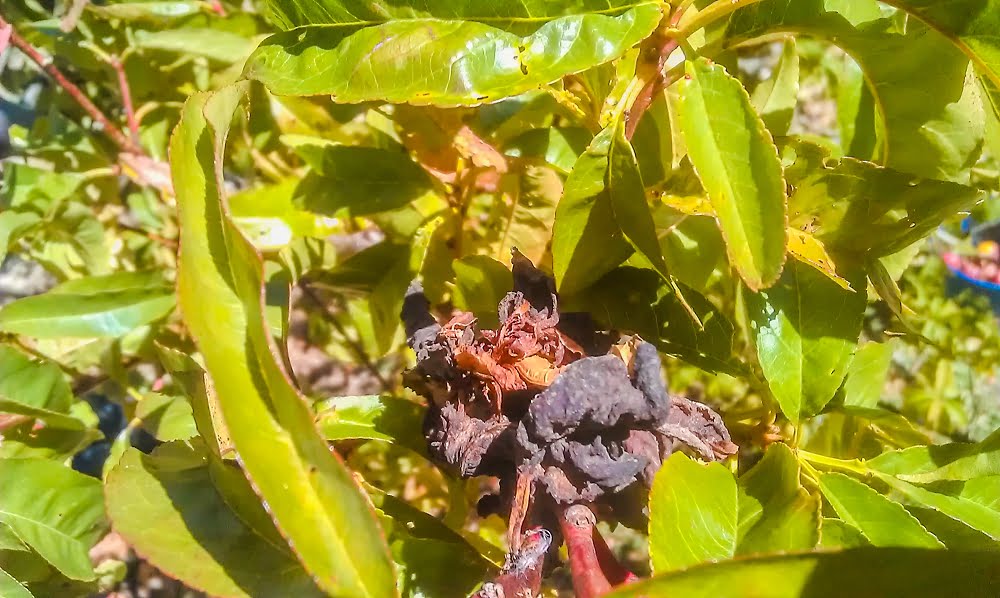
This is one of the diagnostic tools you can use to help identify whether your trees had this disease. It’s all part of the ongoing detective work you need to do to become an awesome fruit grower.
These dead and shriveled leaves are a powerhouse of fungal spores sitting in the tree. They’re just waiting to infect the buds that are forming this year and start the disease cycle all over again.
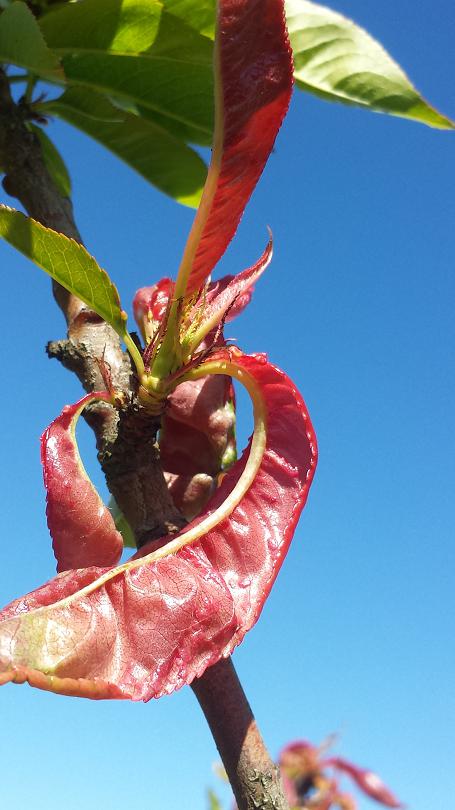
Preventing Leaf curl disease
It’s been often and hotly debated whether it’s worth taking off the infected leaves from the tree as they emerge in spring. On balance, the answer seems to be no. There’s no evidence to show that it reduces the spread of infection once it’s started.
However, the jury is still out on whether removing the leaves in summer will help prevent re-infection the following spring. Here at Grow Great Fruit central we always err on the side of caution.
So…if you have the time and feel like it, you may as well get rid of them!
Many of these leaves will probably have fallen off of their own accord and rotted away under the tree. As long as they’re no longer visible, you can safely assume they’re not a risk. If there are any still in your trees, it can’t hurt to remove and dispose of them.
Hot compost is the perfect way to get rid of them. The high temperatures in the compost pile will kill off the fungal spores. This also preserves the organic matter in the leaves.
Prevention is better than cure
Remember, prevention is much better than cure. Hygiene is one of the best defenses you have against all pests and diseases.
The most important defence against Leaf curl is to spray with an organic fungicide, at the right time.
This latter factor is absolutely key. It can be different for every variety! It’s important to understand how to safely and effectively spray your trees at the right time.
Another key to success is to use ONLY organic sprays. This avoids damage to the trees and the environment.
Curly leaves caused by insects
If you notice curly leaves in your plum trees, it must have a different cause. As we mentioned, peach Leaf Curl disease only affects peach and nectarine trees.
The most likely culprit for curly leaves in plum trees is aphids.
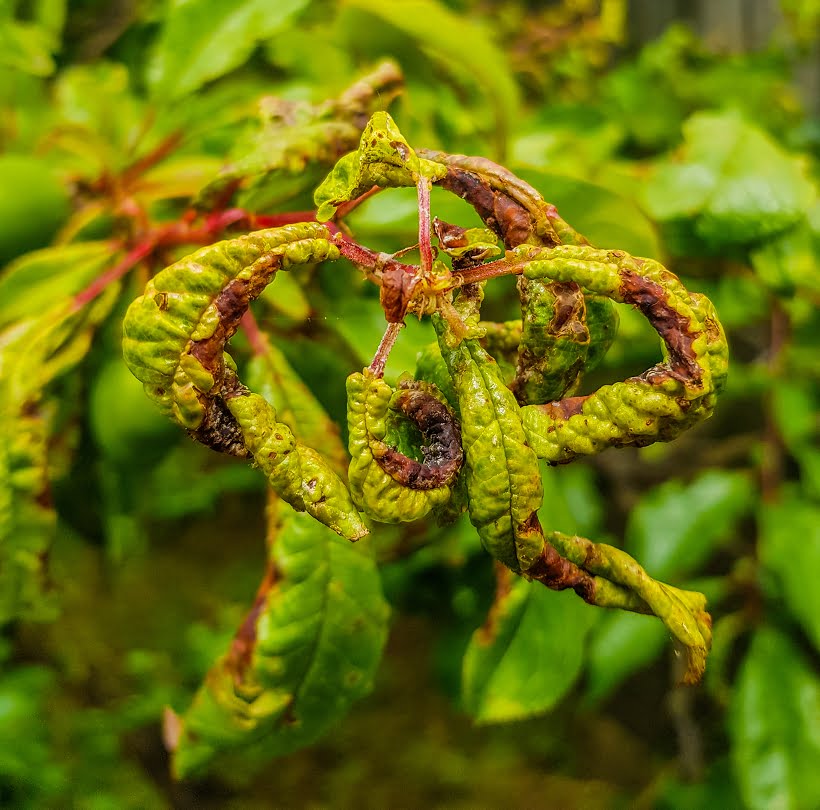
This photo (above) shows the curly leaves you would typically see as a result of an aphid outbreak.
Here’s another example (below), this time in a peach tree. It’s important to note that both black and green aphids can affect peach and nectarine trees.
So, if you have curly leaves in your peach trees, there are multiple potential causes!

If you have curly leaves on your fruit trees, the first step is to carefully look inside the leaves. Even if you can’t see insects crawling around visibly, look carefully inside a few of the curled-up leaves.
In particular, look for any sap-sucking insects (like aphids) that might be lurking in there.
Even if you can’t see any live insects, check very carefully for tiny, dried-up insect bodies. This will tell you if there were aphids, but they’ve already been taken care of by predators.
Nutritional issues can cause curly leaves
The third main reason you might see curly leaves in your fruit tree is because of nutritional problems. Essentially, the tree can’t get the nutrients it needs from the soil. This is commonly seen in lemon trees, for example.
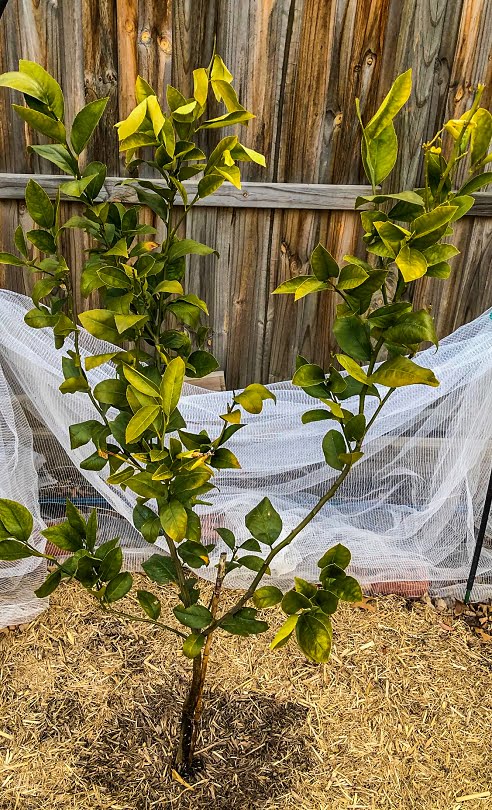
In young trees, this may have happened because the tree’s roots were damaged or dried out when the tree was being planted.
It could also be because of the particular soil in or under the hole where this tree was planted. It could also possibly be because the particular variety is not happy here for some reason.
The most likely answer is in the soil.
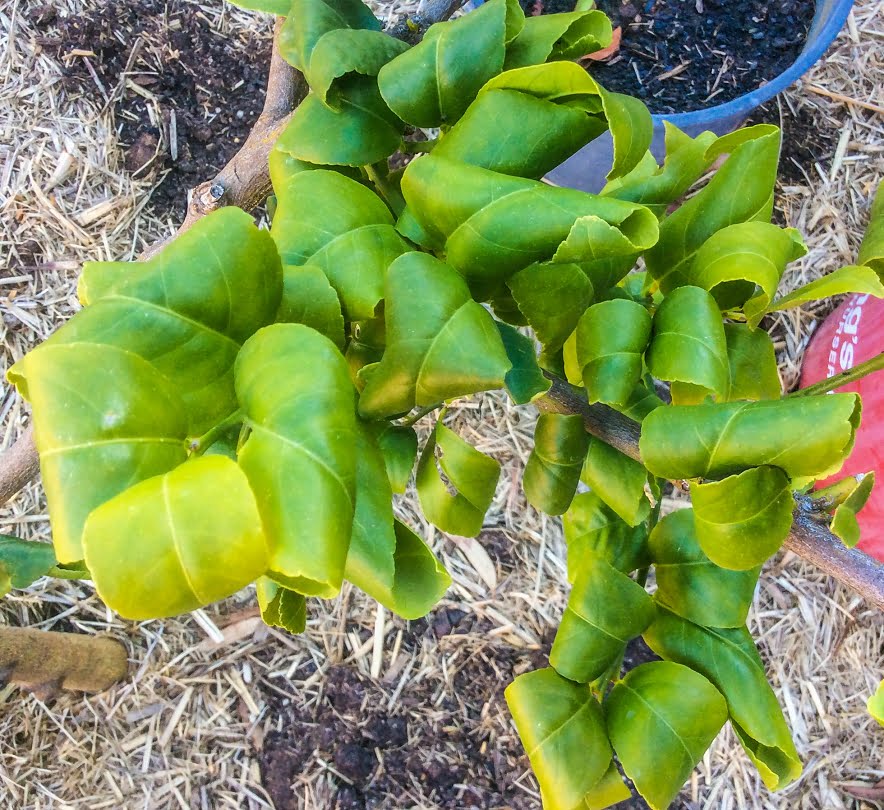
The solution is to improve the health of your soil. Bear in mind that citrus trees are heavy feeders. This means they need access to more nutrition than many other fruit trees. This may mean adding extra compost or aged manure than you do to your other trees.
Is mulch good for soil health?
Mulch under your trees may also be part of the problem. In general, mulch is fine, but it’s not as good (in terms of building healthy soil as quickly as possible) as having plants growing under them.
Your aim should be to have a variety of green and growing plants under your fruit trees all year. In the terminology of eminent soil scientist Dr. Christine Jones, this is called “year-long green”.
The fabulous Dr. Jones presented two masterclasses for us on building soil health and establishing living understorey beneath your fruit trees. They’ll change the way you think about “weeds”, particularly under your fruit trees.
It can be useful to think of the space under your fruit trees as more garden bed space. You may be able to use the space to grow herbs or veggies, for example.
Depending on how you like to garden, it can also be useful to choose some perennial groundcover plants (like flowers) for these beds. These take less work to care for and replace than annual vegetables.
How can water make the leaves on your fruit tree go curly?
Strangely, both over and under-watering can be the cause.
Underwatering (also called water stress) will often show up as curled leaves. The leaves will often curl in a longitudinal fashion, i.e. they curl in on themselves lengthwise. This is different from the outward mid-leaf curling that is typical of nutritional issues that you can see in the photo above.
Over-watering can also show up in the leaves. While there may be some curling associated, the more common symptom is for leaves to go brown and crunchy.
If you’re not sure what you’re seeing and suspect it may be related to water, ask yourself the following questions:
- is the tree getting watered enough?
- are you monitoring the soil moisture?
- could the site have poor drainage?
- any signs that it’s waterlogged?
Water stress is easily remedied. Just water the tree more!
Excess water can be more difficult to solve. The first thing is to figure out where the water is coming from. The area may be getting constant outflow from natural drainage, greywater, or a drainpipe, for example.
Curly leaves on your fruit trees can be caused by lots of different things. The good news is that once you’ve figured out the culprit, finding a cure is much easier!
Related Articles
Why you should pick up fruit from the ground
Picking up your fruit from the ground is the first principle of organic orchard hygiene, and one of your best lines of defence against pests.
How to make the simplest fruit dessert in the world
Summer calls for fruit desserts, and this is one of our simple “go to” recipes. We don’t have time to fuss, but we still love our food!
The benefits of a loquat tree (and 5 delicious recipes)
Discover the many benefits that loquats can bring to your garden, plus enjoy 5 delicious recipes for using them when you have a glut.

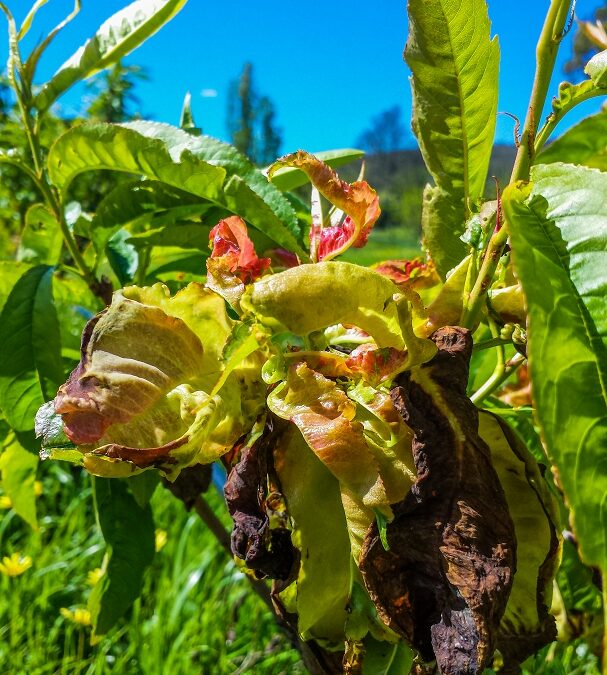

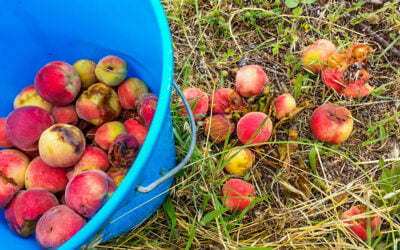
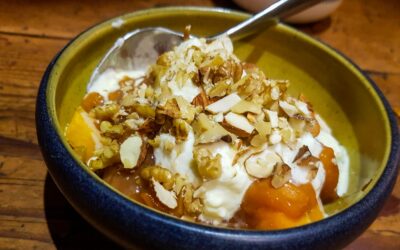
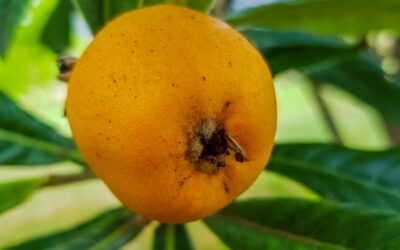


I have newly planted peach and nectarine trees. My established peach trees have leaf curl. Two questions:
Will removing the infected trees help the new trees to stay safe.
If not, should I remove all of the fruit from the infected 4 year old trees
Hi Julie,
Removing the infected trees is a drastic step and not one we’d recommend! If untreated, leaf curl will spread to other peach and nectarines around. The spores live in the leaf buds rather than the fruit, so removing the fruit won’t help.
The good news is it’s easy to treat. Spray once with copper at the first sign of budswell, and then again 7-10 days later – that’s it!
You may find some of our short courses on organic pest & disease management useful.
I loved your blog and thanks for publishing this content about the diagnosing leaf curl in summer!! I am really happy to come across this exceptionally well written content. I like how you have researched and presented these exact points so clearly. Thanks for sharing and look for more in future!!
Hey Putaruru – thanks for the feedback, so glad to hear you’re finding our content useful!
please tell me it is equally as easy to control brown rot.Every summer I lose fifty percent of plums and peaches to this.. and 90% percent of nectarines. My gardener is at a loss as he sprays to prevent.
Our small orchard is well ventilated and we do not water .
Our climate was once Mediterranean but is increasingly humid.
I was so frustrated last year after three consecutive years of losing an entire unripe laden nectarine tree that on my gardeners advice I cut the tree down..he thought as alate season nectarine we would never be able to get fruit without this problem..
Hi Robbie, most seasons it’s pretty easy to control brown rot, it’s only in really wet seasons that it can get away from you. What is your gardener spraying, and when? You can see our suggested organic spray program to prevent brown rot in this course: https://growgreatfruit.com/product/keep-your-fruit-trees-free-from-disease/ to see how it compares. We always recommend NOT removing a tree, but trying to get on top of the problem instead. Pruning to keep the tree really open can also help. The main things to aim for are (1) use preventive sprays early in the season to prevent primary infection, (2) maximise drying capacity because one of the biggest risk factors is the length of time a tree stays wet, and (3) good hygiene throughout the season. Best of luck.
We had some brown rot problems on one of our peach trees this past year: a heritage flat white peach that is delicious. It being a wet year and us not pruning sufficiently to open up the middle of the tree may have contributed to this disease. We did remove and burn affected fruit, but of course did not get all of the fruit before fruit-fall. I have heard that planting garlic under a brown rot affected tree is a useful protection. Am interested in your perspective about this possible solution.
Hi Saide, planting other crops under fruit trees is definitely a good idea (check out this excellent masterclass by soil expert Dr. Christine Jones if you haven’t seen it yet – https://growgreatfruit.com/product/the-under-story-masterclass/). However, by itself, it won’t prevent Brown rot. Luckily, it’s actually relatively easy to prevent the disease by spraying with organic fungicides like wettable sulphur at the right time a couple of times in spring, and then throughout the season as needed, in response to the weather – it’s all explained in this short course – https://growgreatfruit.com/product/keep-your-fruit-trees-free-from-disease/
We planted an O’Henry peach tree last Summer. It flowered beautifully, but once the leaves emerged they were heavily infected with peach leaf curl. The tree at this point (May 1st in Northern California) has a lot of fruits forming, which look good, but there are very few leaves on the tree. So far, it hasn’t grown any new ones in place of the lost infected ones. I thinned the fruits out so that no branch has more than two, but I am still worried about the health of the tree putting so much energy into producing the fruit, but with only a few leaves to support the needs of the tree. Should I remove all the fruit so that the tree can just concentrate on itself, and then wait until next year to spray properly and hopefully avoid the disease next year? My husband says leave it alone and let nature do it’s thing… but, I think peach trees need intervention and extra care, right? Thank you for your reply.
Hi Amy, it’s a tricky situation, isn’t it? You’re right, the peach tree needs some leaves if it’s going to be able to carry the fruit to ripeness, so it’s a bit disturbing that the new leaves aren’t coming through – that’s what we’d expect to see after a bad case of leaf curl. It can take a while though, so be patient and wait to see what happens before you pull more fruit off. But a second thinning is probably a good idea to help the tree along a bit. The good thing about O’Henry is that they’re late season, so as long as some leaves appear soon, the tree has plenty of time to bring the fruit to fruition.
Hi, both my nectarine and peach trees have bad leaf curl and two nursery’s have suggested I remove them. How long should I leave the soil to regenerate before I put in new trees that will be a fig and pear?
Hi Ryan, we definitely don’t agree with the suggestion to pull the trees out. Leaf curl is (mostly) preventable if you use the right sprays at the right time – it’s explained in detail in this short course: https://growgreatfruit.com/product/keep-your-fruit-trees-free-from-disease/. Re your question, the right time to plant new trees would be next winter, and there’s no need to specifically regenerate the soil (as the leaf curl disease is nothing to do with the soil, it’s an endemic fungal disease that shows up when the weather conditions favour the fungus.) Having said that, we do recommend continuously working on improving the soil anyway, regardless of whether you replace the trees or not.
I’ve had the problem of leaf curl due to aphids on plum trees. Spraying with oil kills the aphids that the oil covers but I find it difficult to spray the oil onto all parts of the leaves as they are curled up so how can the oil get to them? what would you suggest?
I have got rid of nearly all of my leaf curl. I was a little late with the spraying this season so we did get some. However, before the first spray I removed all of the infected leaves & sprayed again the following weekend. Then on a regular basis of say every 3 days I would walk around them again and removed any infected leaves again.
I have plenty of fruit coming on.
Just goes to show how paying close attention can really help! Nice work Andrew and enjoy your fruit :). Meg – GGF team.
Again I have to THANK the GGF course content with Katie and Hugh.
Following the information given , my trees are so healthy and have so much new growth showing. I’ve had no aphids at all and no leaf curl thanks to the fabulous spray program you have.
But…. Thrip has shown up on a 2nd Nectarine. Not badly but will need to read up your advice again on how to deal with it during winter.
You wouldn’t believe it when you look at the pictures of our huge fire that ripped thru here.
Forever grateful.
Thank you Elle! Thrips do overwinter in mulch and leaf litter , but there are plenty of ways to reduce their populations if they are causing damage to the tree (many of which you’re probably already doing!). Approach is similar to dealing with aphids or any other sap-sucking insects. They are probably loving this wet weather too! Take care, Meg – GGF team.